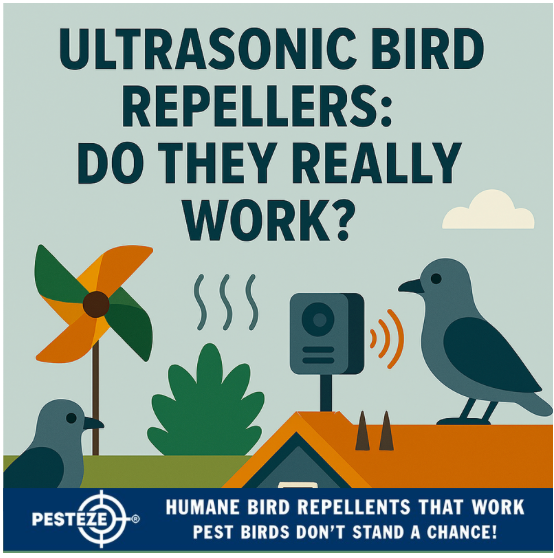ULTRASONIC BIRD REPELLERS: DO THEY REALLY WORK?

ULTRASONIC BIRD REPELLERS: DO THEY REALLY WORK?
SUMMARY
Ultrasonic bird repellers promise silent, invisible bird control using high-frequency sound waves, but their effectiveness varies significantly based on species, placement, and environmental factors. This evidence-based guide examines the science behind ultrasonic technology and provides realistic expectations for their performance.
FEATURES
- Scientific Analysis: Research-backed evaluation of ultrasonic technology effectiveness on different bird species.
- Performance Factors: Environmental conditions and placement strategies that impact success rates.
- Species Specificity: Which birds respond to ultrasonic frequencies and which remain unaffected.
- Technology Comparison: Solar-powered, plug-in, and battery-operated ultrasonic device differences.
- Cost-Benefit Assessment: Real-world performance versus investment for various applications.
- Integration Strategies: How to combine ultrasonic repellers with other deterrent methods effectively.
GUIDE DESCRIPTION
Ultrasonic bird repellers generate high-frequency sound waves (typically 15-25 kHz) that are inaudible to humans but theoretically uncomfortable for birds. While the technology sounds promising, scientific studies and field testingreveal a complex picture of effectiveness that depends heavily on bird species, environmental conditions, and proper implementation.
Research findings show mixed results for ultrasonic bird deterrents. Some studies demonstrate short-term effectiveness against certain species, particularly smaller songbirds, while larger birds like pigeons, crows, and geeseoften show minimal response to ultrasonic frequencies. Habituation occurs quickly in many cases, with birds returning to treated areas within days or weeks of initial installation.
Species-specific responses vary dramatically based on hearing ranges and behavioral patterns. Sparrows, starlings, and finches may initially avoid ultrasonic-treated areas, while raptors, corvids, and waterfowl typically show little to no response. Frequency sweeping and variable patterns improve effectiveness compared to constant-tone devices, but results remain inconsistent across species.
Environmental factors significantly impact ultrasonic performance. Wind, rain, and temperature can scatter or absorb sound waves, reducing effective range. Physical obstacles like walls, vegetation, and structures create sound shadows where birds remain unaffected. Outdoor applications face greater challenges than controlled indoor environmentswhere ultrasonic waves can be more effectively contained.
Device quality and specifications vary widely among manufacturers. Professional-grade units with adjustable frequencies, motion activation, and weatherproof construction generally outperform basic consumer models. Solar-powered devices offer continuous operation but may have reduced power output, while plug-in models provide consistent frequency generation in accessible locations.
Placement strategy is critical for any potential success with ultrasonic repellers. Multiple units positioned strategicallycan create overlapping coverage areas, while elevation and angle adjustments help direct sound waves toward problem areas. Regular repositioning may help prevent habituation, though this requires ongoing maintenance effort.
Realistic expectations are essential when considering ultrasonic bird repellers. They work best as part of integrated pest management rather than standalone solutions. Combining ultrasonic devices with visual deterrents, physical barriers, and habitat modification can enhance overall effectiveness while providing backup methods when ultrasonic performance declines.
Cost considerations should factor in limited lifespan and effectiveness duration. Most ultrasonic repellers require replacement every 1-3 years, and effectiveness often diminishes within the first few months of use. Professional installation and maintenance add to total ownership costs without guaranteeing improved results.
Alternative technologies like motion-activated sprinklers, reflective deterrents, and physical barriers often provide more reliable and long-lasting results than ultrasonic devices alone. Evidence-based deterrent selection should prioritize proven methods while considering ultrasonic repellers as supplementary tools rather than primary solutions.
The bottom line: ultrasonic bird repellers can provide temporary relief in specific situations but should not be relied upon as complete bird control solutions. Success rates improve when combined with other methods and when realistic expectations are maintained about their limitations and lifespan.
- Pukhraj Sharma


Comments 0